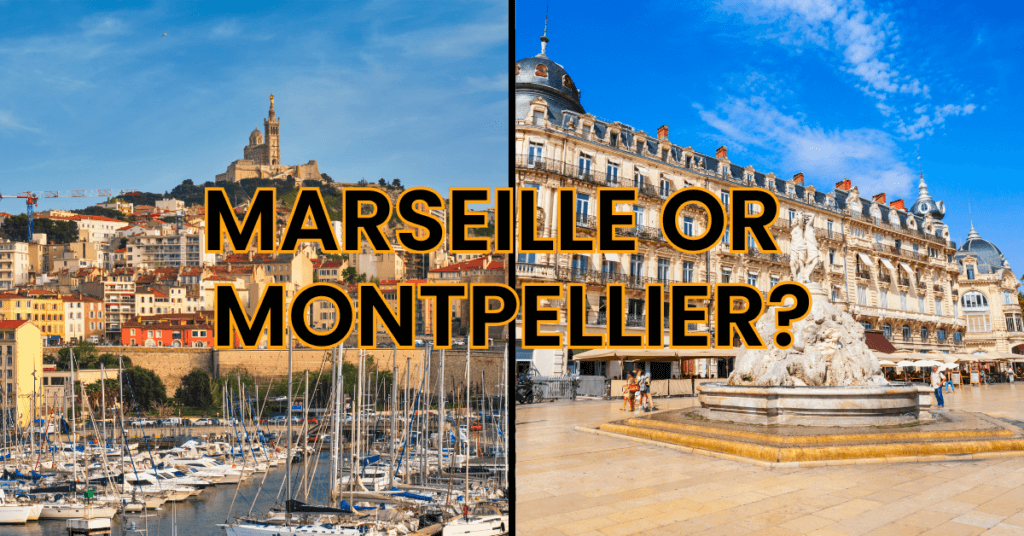Marseille or Montpellier? Which city should you visit?
Having a hard time picking between Marseille or Montpellier for your next French trip? Let this guide help you make up your mind! Here’s what you can expect from both cities:
🏛 History Buffs: Marseille is France’s oldest city and edges out Montpellier here with its abundance historical sites like Château d’lf and Fort Saint-jean
🏖 Beach Lovers: Whilst Montpellier is only 7km away from the beach, Marseille not only has a number of beaches right on its doorstep but it has the incredible Calanques National Park,
🥐 Foodies: Marseille may be world famous for its seafood and Bouillabaisse but its restaurants scene is also extremely varied. The food in Montpellier is great but there isn’t quite as much variety as Marseille.
🌳 Nature Enthusiasts: Marseille’s Calanques National Park is a world class destination for those that love the outdoors. Montpellier’s Maison de la Nature is beautiful but it can’t match the jaw dropping Calanques.
🏢 Urban Explorers: Both of these cities are amazing to explore. Montpellier doesn’t have as much to see as Marseille but it’s a bit less touristy so might be better for those that like exploring less visited destinations.
🍷 Wine Lovers: Whilst Marseille is situated in the Provence wine region there aren’t many local vineyards. Whereas Montpellier is surrounded by them making it a haven for wine lovers.
🎒 Backpackers: Montpellier’s less touristy feel and lower cost of living make it perfect for backpackers wanting a cheaper break.
👵 Over 60’s: Montpellier’s flat terrain, beautiful old town and relaxing squares make it a fantastic destination for the over 60’s. Marseille is offers more to do, but it’s hilly and gets crowded in peak season.
👨👩👦 Family-Friendly: Montpellier boasts plenty of public parks, gardens, and family-oriented activities like the Montpellier Zoo. The city’s flatter terrain also makes it easier for push chairs or little legs. Marseille, while offering great beaches and boat trips, is busier and might need more planning for family outings. We’d say Montpellier is a better destination for a family trip.
If you love beaches, seafood and outdoor activities Marseille is definitely for you. On the flip side if you’re looking for a more relaxing vibe, plenty of vineyard visits and a more family friendly destination, choose Montpellier.
Not convinced yet? Keep reading to get the full scoop on these two fascinating cities.
Marseille
Marseille might not boast the romantic allure of Paris or the glamour of the French Riviera, but its unique charm is undeniable. Perched on the Mediterranean coast, Marseille is a melting pot of cultures, an attribute reflected in its vibrant streets and diverse cuisine. With a history dating back to ancient Greece, it’s a paradise for those who love delving into the past.
Its old port, Vieux Port, bustles with fish markets and boats, while the iconic Notre-Dame de la Garde basilica watches over the city from a hilltop. But there’s more to Marseille than just history and picturesque views. It’s also a city of dynamic cultural life, with a myriad of museums, art galleries, and music festivals. If you’re in search of a city that combines rich heritage, gastronomic delights, and a laid-back seaside atmosphere, Marseille is the place to be.
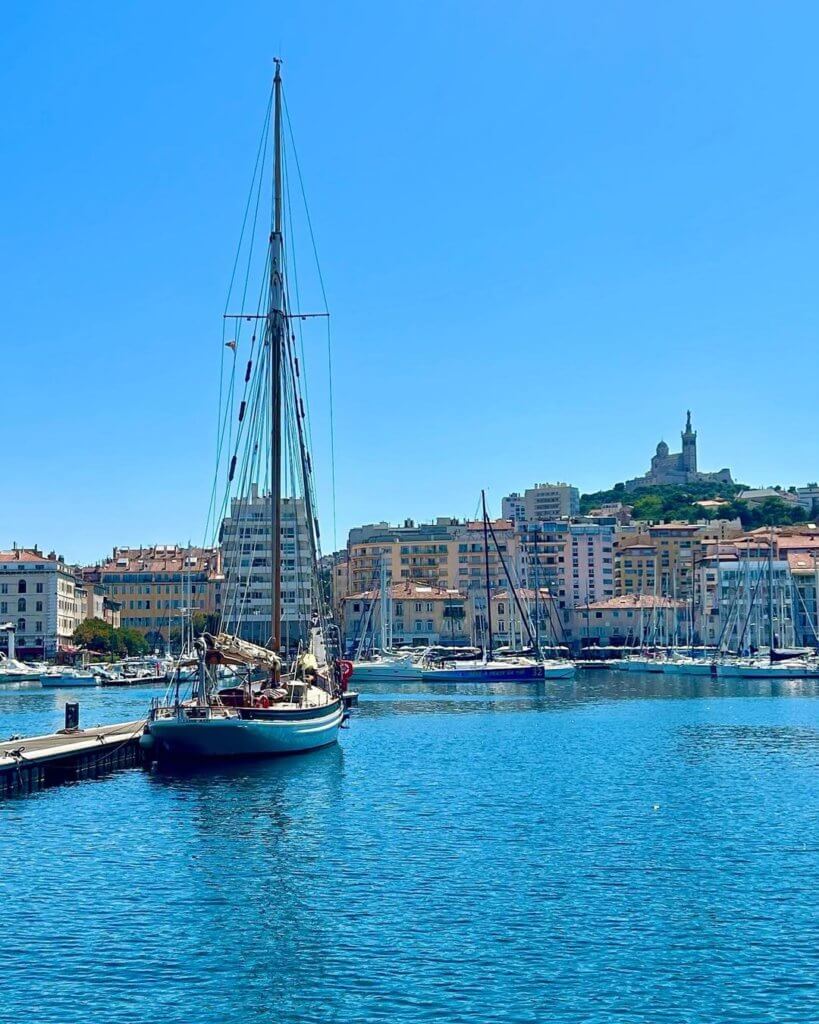
Montpellier
Don’t overlook Montpellier just because it isn’t as famous as Paris or as glitzy as Cannes. This city, near France’s Mediterranean coast, has its own charm. Montpellier is a lively place where lots of cultures come together. You can taste this in the delicious variety of food the city has to offer.
If you love history, Montpellier has lots to offer. The city has been around since the Middle Ages. Its old part of town, Ecusson, is full of tiny, winding streets and hidden squares, waiting for you to explore them. And, of course, you can’t miss the city’s own Arc de Triomphe.
But Montpellier is more than old buildings and good food. The city loves arts and culture, too. You can visit lots of museums, art centres and even catch a festival if you time your visit right. If you want a mix of history, food and a laid-back beach feel, Montpellier could be just the right place for you to visit.
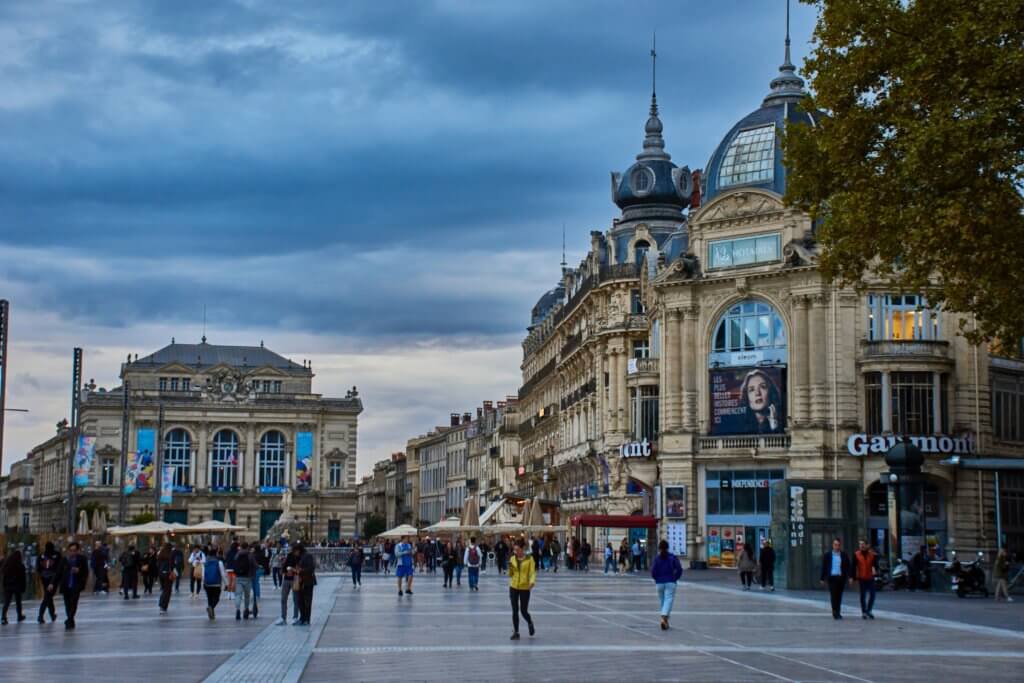
While we’re comparing Marseille and Montpellier in this post, we’ve also looked at how Marseille stacks up against other cities like Biarritz, Cannes or Toulouse. We’ve linked to those articles below if you want to take a look!
Pros and Cons of Marseille and Montpellier
Marseille Pros:
- 🏛 History: Oldest city in France, lots of historical places to visit.
- 🏖 Beaches: Easy access to beaches and close to Calanques National Park.
- 🥘 Cuisine: Known for seafood, especially Bouillabaisse.
- 🚢 Port: Big port city, great for sea trips and exploring the Mediterranean.
Marseille Cons:
- 💸 Cost: Can get expensive, particularly in tourist-heavy spots.
- 👫 Crowds: Gets busy, especially in peak seasons.
- 🌄 Terrain: It’s hilly, might be an issue for some.
- 🔒 Safety: Some parts of the city are less safe than others.
Montpellier Pros:
- 🍇 Wine: Surrounded by vineyards and wine country.
- 🏢 Less Touristy: Less crowded and a more laid-back vibe.
- 🎓 University Town: Young, dynamic atmosphere due to large student population.
- 👴 Flat Terrain: Easier to navigate for those who might struggle with hills.
Montpellier Cons:
- 🏖 Beach Distance: Beaches are around 7 km away, so not right at your doorstep.
- 🥘 Cuisine: Food scene is not as varied as Marseille’s.
- 💡 Fewer Landmarks: Doesn’t have as many historical landmarks.
- 🚌 Public Transport: Not as many transport options as in Marseille.
How long to stay in Marseille
Deciding on the ideal length for your Marseille visit can be a bit complex, given the rich cultural, historical, and natural attractions the city offers. The city has an abundance of experiences that can keep you engaged for days on end, but how long to stay will largely depend on your personal interests.
If your primary goal is to experience the unique Mediterranean vibe of the city, sample local seafood, and explore the historic district, a 2 to 3 day visit might suffice. This should give you ample time to wander through the narrow streets of Le Panier, the city’s old town, take a leisurely walk around the Vieux Port, and indulge in authentic bouillabaisse at a seaside restaurant.
For travellers drawn to Marseille’s rich history and culture, a stay of 4-5 days would be ideal. This gives you enough time to visit the iconic Basilique Notre-Dame de la Garde, explore the Museum of European and Mediterranean Civilisations (MUCEM), and take a ferry to the historic Château d’If, without feeling rushed.
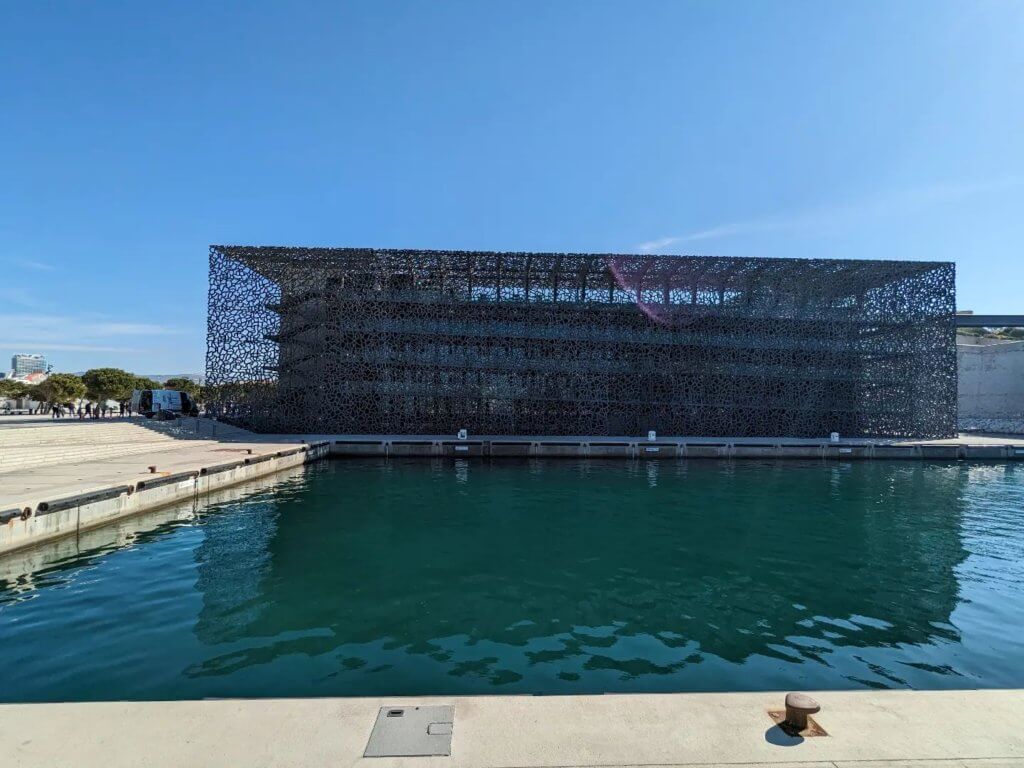
However, if you’re like me and prefer a deeper immersion into the local culture, you might want to consider staying longer. A week in Marseille would provide ample time to not only explore the city’s attractions, but also to enjoy its beautiful beaches, take day trips to the nearby Calanques National Park or the charming town of Cassis, and truly soak up the laid-back Marseille lifestyle.
How long to stay in Montpellier
Choosing the right amount of time to spend in Montpellier might seem challenging, considering the city’s vibrant culture, historic gems, and pleasant Mediterranean climate. The length of your stay really depends on your personal interests and the pace at which you want to explore.
If your aim is to get a taste of the city’s lively atmosphere, wander through the picturesque old town, and sample local cuisine, a visit of 2 to 3 days should be sufficient. This allows you enough time to explore the charming pedestrian-only streets of the Ecusson, enjoy a coffee at the Place de la Comédie, and relish local delicacies at a traditional restaurant.
However, if you’re interested in delving deeper into Montpellier’s rich history and culture, a 4 to 5 day visit would be more suitable. This gives you ample time to explore historic sites like the Cathedral Saint Pierre, check out art collections at the Fabre Museum, and visit the stunning botanical garden without feeling rushed.
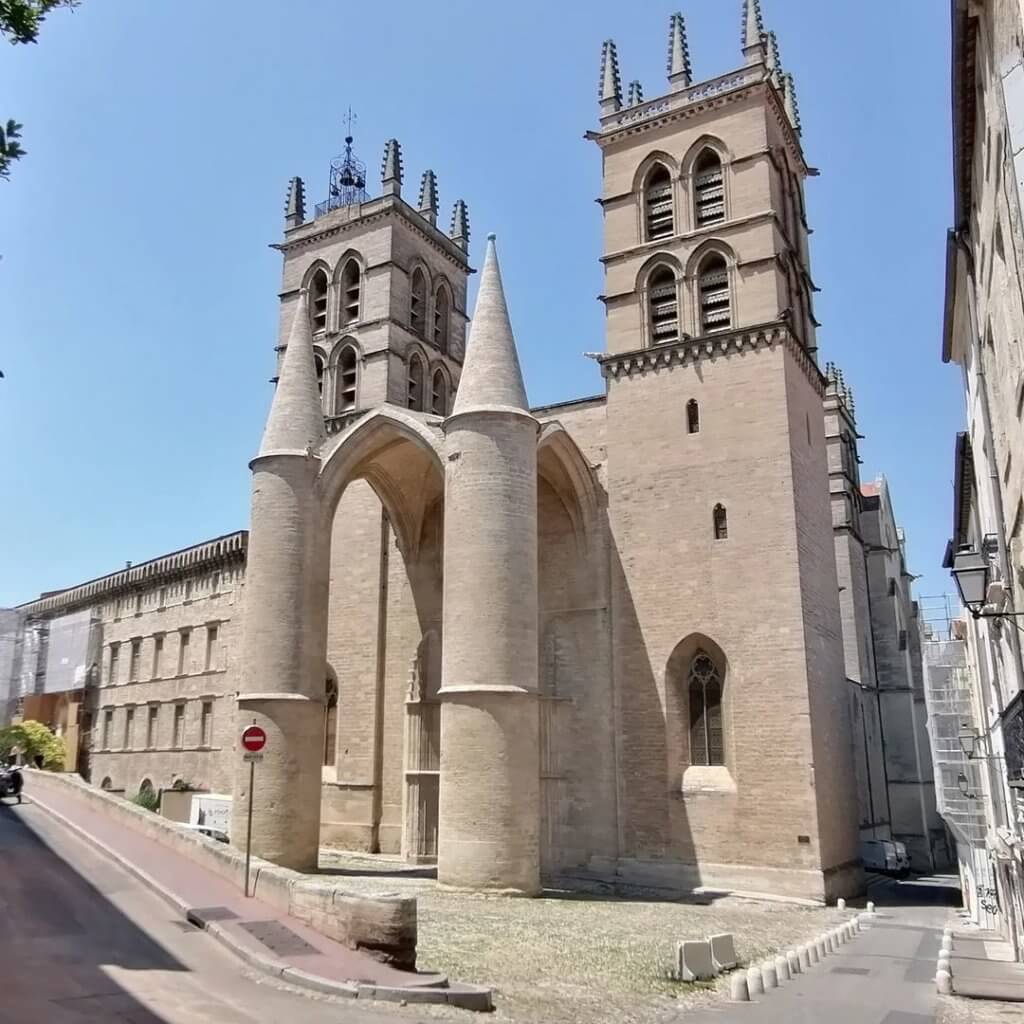
But, if you’re looking for a more immersive experience, a week in Montpellier would be a fantastic choice. This duration would not only let you thoroughly explore city attractions but also allow time for relaxing at nearby Mediterranean beaches, taking day trips to fascinating spots like the medieval town of Aigues-Mortes or the impressive Roman aqueduct, Pont du Gard, and truly absorbing the vibrant, student-friendly vibe of Montpellier.
How much is food and drink in Marseille and Montpellier?
| Item | Marseille Average Prices (€) | Montpellier Average Prices (€) |
|---|---|---|
| 🍺 Beer | €5 – €8 | €5 – €7 |
| Glass of Wine | €4 – €10 | €4 – €9 |
| Coffee | €2 – €4 | €2 – €4 |
| Meal at Midrange Restaurant | €20 – €40 | €20 – €40 |
These are estimated average prices for food and drink in both Marseille and Montpellier. Actual prices may vary based on the specific establishment and location.
How much is it to stay in Marseille or Montpellier?
| Type of Accommodation | Marseille Average Prices (€) | Montpellier Average Prices (€) |
|---|---|---|
| Luxury Hotel | €150 – €500 | €200 – €600 |
| Midrange Hotel | €80 – €150 | €80 – €150 |
| Budget Hotel | €40 – €80 | €50 – €80 |
| Hostel | €20 – €40 | €20 – €40 |
These are estimated average prices for accommodation in both Marseille and Montpellier. Actual prices may vary based on the specific hotel or hostel, time of year, and location within the city.
When is the best time to visit Marseille?
🌸 Spring: From April to June, the weather in Marseille is comfortably warm, with temperatures averaging between 15-23°C (59-73°F). The city isn’t too crowded, and the beautiful calanques (rocky inlets) are perfect for hiking and picnicking.
☀️ Summer: July and August are the hottest months, with temperatures reaching 30°C (86°F). It’s a great time for beach activities, water sports, and enjoying the vibrant nightlife. However, it’s also peak tourist season, so it can get crowded, and prices for accommodation can be higher.
🍂 Autumn: September to October is another lovely period to visit. The weather remains warm but becomes more comfortable. It’s an ideal time to explore the city and its surrounding countryside without the summer crowds. Also, the sea is still warm enough for swimming.
❄️ Winter: From November to March, Marseille experiences mild winters compared to other parts of France. While it isn’t beach weather, it’s a good time to explore the city’s museums and historical landmarks. There are fewer tourists, and you might find some great deals on accommodation.
However, always remember to check the local weather forecast before your trip, as weather conditions can change unexpectedly.
When is the best time to visit Montpellier?
🌸 Spring: Between April and June, Montpellier is quite pleasant with average temperatures ranging from 15-25°C (59-77°F). The city starts to come alive with various outdoor events, and the landscapes are beautifully lush, making it an ideal time for sightseeing and enjoying the local parks.
☀️ Summer: From July to August, temperatures can soar up to 30°C (86°F), making it perfect for beach visits as Montpellier is just a short distance from the Mediterranean Sea. Be aware, though, that it’s also peak tourist season, so the city can get crowded, and prices might be higher.
🍂 Autumn: September to October offers comfortable temperatures around 20-25°C (68-77°F). The city is less crowded during these months, and it’s a great time to explore the historical sites and enjoy local outdoor cafes.
❄️ Winter: November to March can be quite mild with temperatures around 10-15°C (50-59°F), though it can occasionally drop lower. While it’s not the best time for outdoor activities, it’s a good time to explore Montpellier’s museums and indoor attractions.
Do remember to check the weather forecast close to your travel dates as conditions can sometimes change unexpectedly.
Average Monthly Temperatures
| Month | Marseille (High / Low°C) | Marseille Rain | Montpellier (High / Low°C) | Montpellier Rain |
|---|---|---|---|---|
| January | 12° / 5° | 6 days | 11° / 2° | 5 days |
| February | 13° / 6° | 4 days | 12° / 3° | 4 days |
| March | 16° / 8° | 4 days | 15° / 5° | 4 days |
| April | 18° / 9° | 5 days | 18° / 8° | 5 days |
| May | 23° / 13° | 4 days | 21° / 12° | 4 days |
| June | 26° / 17° | 2 days | 26° / 15° | 3 days |
| July | 29° / 19° | 1 day | 29° / 18° | 2 days |
| August | 29° / 19° | 2 days | 28° / 18° | 2 days |
| September | 26° / 16° | 3 days | 25° / 14° | 3 days |
| October | 21° / 13° | 6 days | 20° / 11° | 5 days |
| November | 16° / 9° | 5 days | 15° / 6° | 5 days |
| December | 13° / 6° | 5 days | 12° / 3° | 4 days |
This table provides a side-by-side comparison of the average monthly temperatures and rainfall for both Marseille and Montpellier throughout the year.
Getting around Marseille:
Marseille has a good public transportation system, including buses, trams, and a metro system. Taxis are also available but can be expensive. Walking is a great way to explore the city centre, but if you want to cover more ground, consider renting a bike or taking a boat tour. The Marseille city pass is worth getting if you’re planning on using public transport.
Getting around Montpellier:
Getting around Montpellier is a breeze thanks to its efficient and well-connected public transportation system.
The city’s tram network covers most of the city and is very easy to use. It’s probably the best way to travel around the city cheaply and easily. The trams are even a sight to see themselves, each line designed by a different artist which gives it all a sense of fun!
On top of the trams, Montpellier also boasts numerous bus lines that can take you to places the trams don’t reach. If you prefer to take control of your own travel, the city has several bike rental services, thanks to its flat layout and plentiful bike lanes. The city centre is primarily pedestrianized, making it easy and delightful to explore on foot. Plus, it’s hard to beat a leisurely stroll through Montpellier’s historic streets!
Top things to do in Marseille
- Old Port (Vieux Port): This bustling harbour is the heart of Marseille. It’s lined with cafes and restaurants, and it’s the perfect place to enjoy a bouillabaisse, the traditional Provençal fish stew. Don’t miss the fish market that takes place every morning at the port.
- Le Panier: Just north of the Old Port is Marseille’s old town, Le Panier. Wander through its narrow, winding streets to discover charming squares, art galleries, boutiques, and cafes.
- Notre-Dame de la Garde: This iconic basilica sits on the city’s highest point and offers panoramic views of Marseille. Its interior is equally stunning with beautiful mosaics.
- The Calanques: These rocky inlets with crystal clear waters are perfect for hiking, swimming, and boating. They can be found along the coastline between Marseille and Cassis.
- MuCEM (Museum of European and Mediterranean Civilisations): This museum is notable not only for its comprehensive exhibits but also for its stunning architecture and sea views.
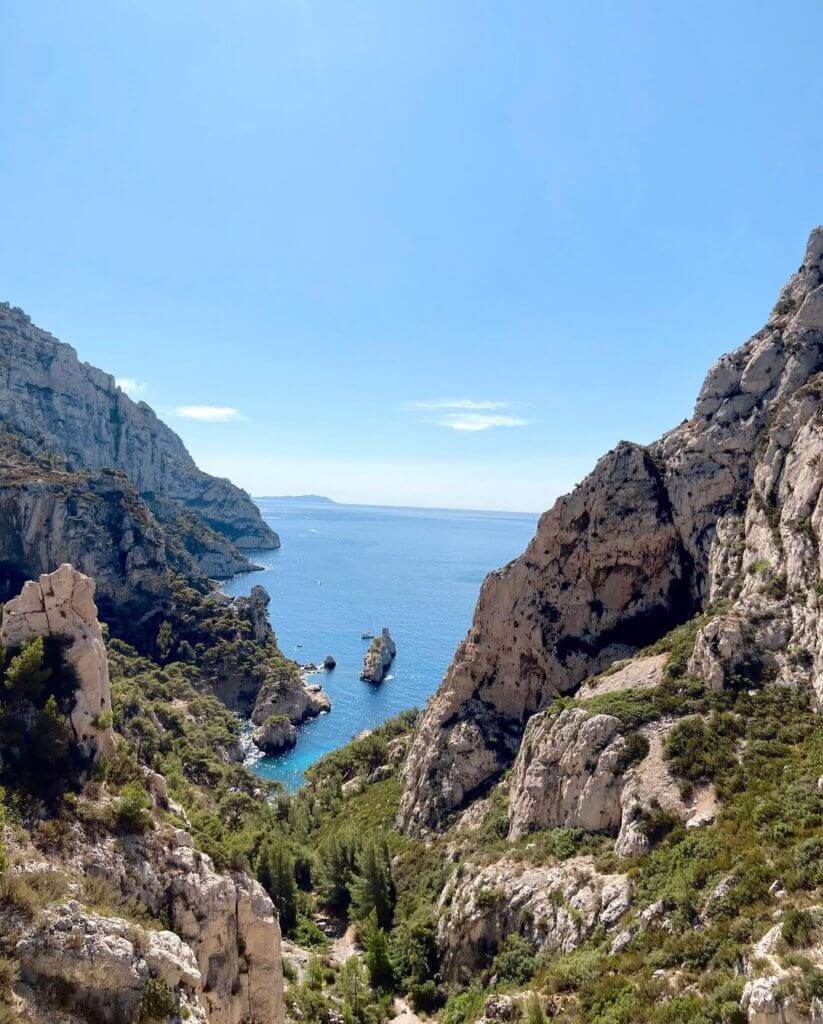
Top things to do in Montpellier
- Place de la Comédie: Often referred to as the heart of Montpellier, this bustling square is surrounded by cafes and restaurants. Here, you can absorb the vibrant city atmosphere and admire the iconic Three Graces fountain in the centre.
- Musée Fabre: A short walk from the Place de la Comédie will lead you to this prominent art museum. It boasts an impressive collection of European art, spanning from the Renaissance to contemporary pieces.
- Montpellier Zoological Park: This extensive zoological park is a paradise for animal lovers, with a wide variety of species and a unique Amazon greenhouse that replicates the Amazon Rainforest’s ecosystem.
- Jardin des Plantes: Established in 1593, this is the oldest botanical garden in France. Take a leisurely stroll through the lush gardens, filled with an array of plant species.
- Antigone District: Just east of the city centre, this district is a testament to Montpellier’s modern architectural achievements. Inspired by Greek and Roman designs, it creates a unique and visually striking urban landscape.

How to spend three days in Marseille
Day 1: Exploring the Heart of Marseille
Kick off your visit to Marseille by exploring the vibrant Vieux Port (Old Port). Watch fishermen selling their catch, enjoy a cup of coffee at one of the numerous waterside cafés, or simply admire the hundreds of moored yachts. Next, stroll to Le Panier, Marseille’s old town, with its charming cobbled streets, colourful houses, artisan shops, and inviting cafés. After lunch in one of the local bistros, take a ride on the tourist train or climb the hill to visit Notre-Dame de la Garde, the city’s iconic basilica, offering panoramic views of Marseille. End your day with a delicious seafood dinner back at the Vieux Port.
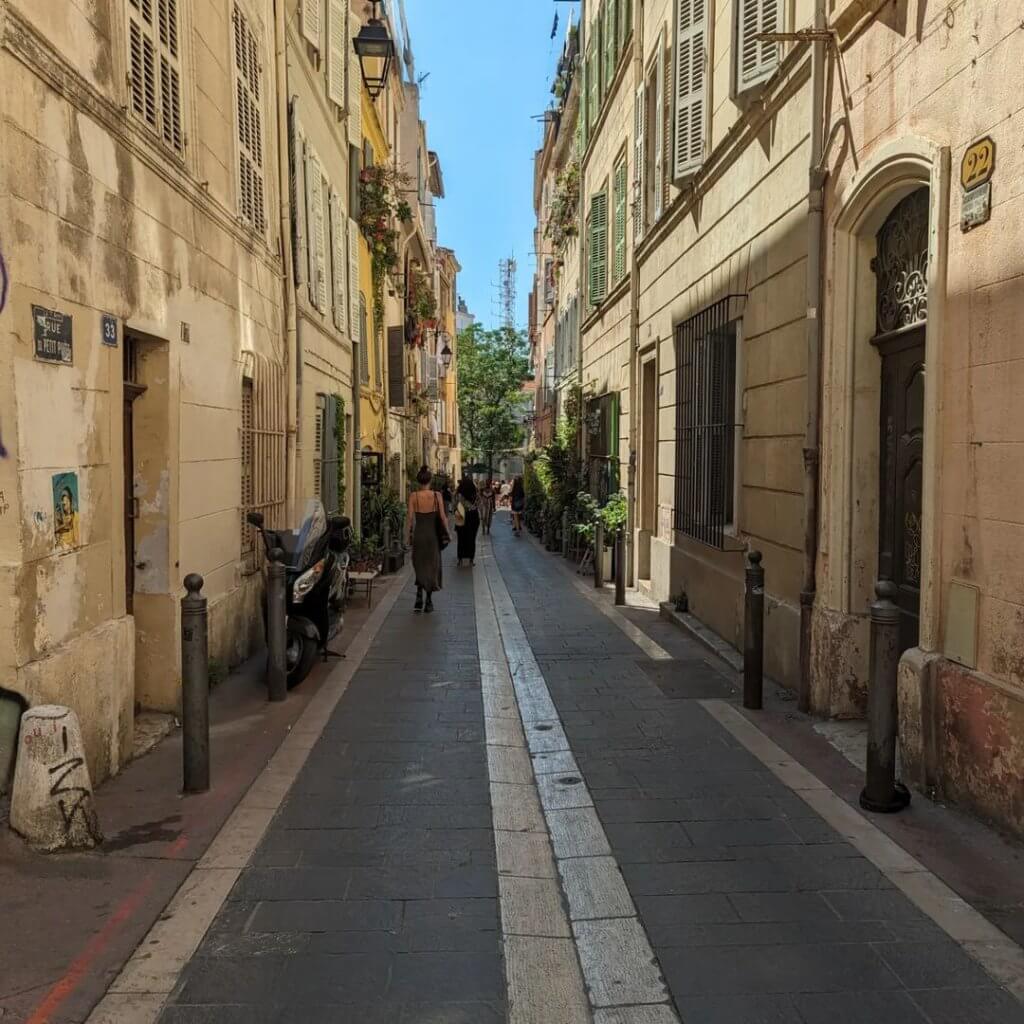
Day 2: Discovering Culture and History
Start your second day at the MuCEM (Museum of European and Mediterranean Civilisations), known for its exhibits as well as its stunning architecture. Then make your way to the Palais Longchamp, home to Marseille’s fine art museum and natural history museum, surrounded by a grand park. After lunch, consider visiting Château d’If, a former fortress and prison on a small island off Marseille’s coast, famously featured in Dumas’ ‘The Count of Monte Cristo.’ Wrap up the day with dinner at one of Marseille’s excellent restaurants, perhaps trying the city’s signature dish, bouillabaisse.
Day 3: Nature and Leisure
Devote your last day in Marseille to the Calanques National Park. Depending on your preference, you can hike, kayak, or take a boat tour to explore these stunning limestone cliffs and turquoise waters. Make sure to pack a picnic to enjoy by the sea. After returning to the city, enjoy a leisure stroll along La Corniche, a scenic seaside boulevard, or visit Prado Beach for a more relaxing time. End your trip with a farewell dinner, relishing the flavours of Provençal cuisine.
How to spend three days in Montpellier
Day 1: Exploring the Heart of Montpellier
Begin your Montpellier adventure at Place de la Comédie, the city’s bustling central square. Enjoy a leisurely breakfast at one of the local cafes and soak in the vibrant atmosphere. Next, explore the surrounding historic district, Ecusson, with its narrow, winding streets, charming squares, and elegant mansions. Post lunch, visit the Montpellier Cathedral and the Musee Fabre, a leading fine arts museum in the region. Finish your day with a delicious dinner at one of the many excellent restaurants in the city centre.
Day 2: Diving into Science and History
Kick off the second day at the Odysseum, a large shopping and leisure centre. Here, you can visit the Planetarium Galilee for a fascinating journey through the cosmos. Later, explore the Château de Flaugergues, a historic castle with beautiful gardens, followed by a wine-tasting tour. In the evening, enjoy a walk along the banks of the Lez River, followed by a dinner featuring local Languedoc cuisine.
Day 3: Enjoying Nature and Leisure
Devote your last day to the outdoors. Start with a visit to the Montpellier Zoological Park, home to a wide variety of species. After a picnic lunch in the park, head to the Lunaret Botanical Garden, the oldest botanical garden in France. Later, you could explore the nearby seaside towns like Palavas-les-Flots or La Grande-Motte, which offer beautiful Mediterranean beaches. End your trip with a farewell dinner in Montpellier, reminiscing over your favourite moments.
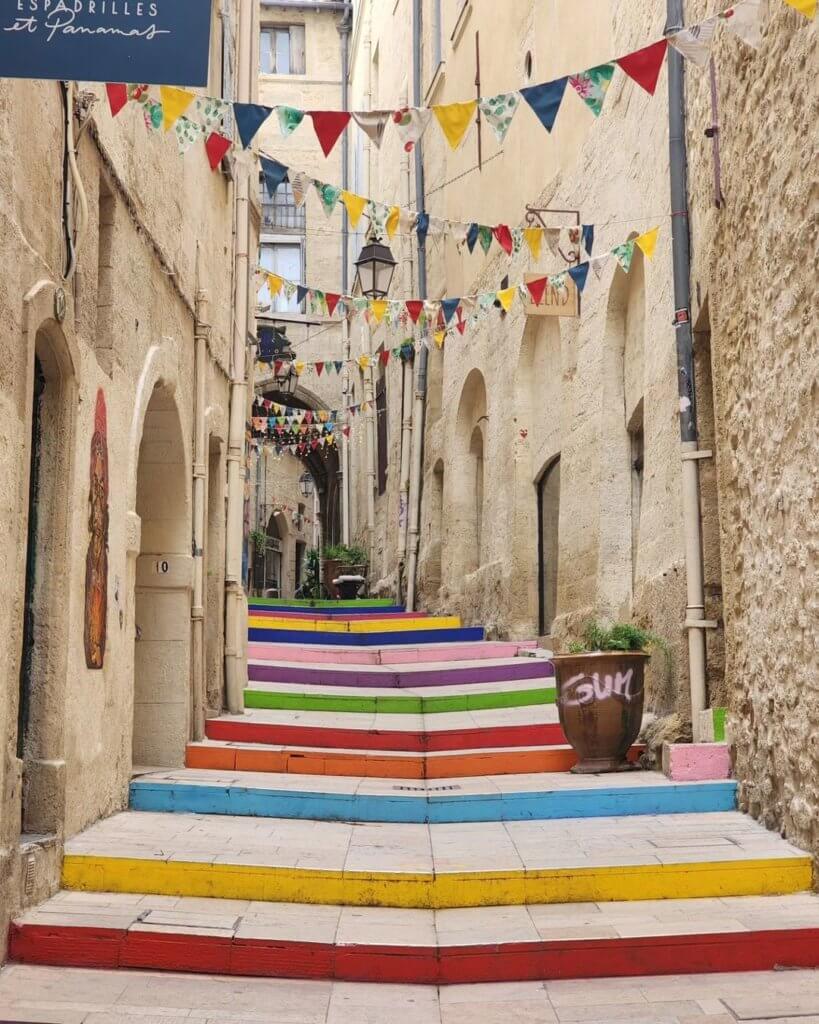
Gareth is an avid city adventurer with a particular passion for finding amazing food! There’s quite literally nothing he doesn’t like. He spends most of his travelling time trying to find great restaurants and cafes to eat at. Alongside trying local street food which he loves! He’s done most of his travelling in Europe so far but would love to visit Japan and Mexico
When not travelling you can find Gareth boxing, running, or in the gym. He’s got a passion for exercise and loves physical challenges.
You can contact him at gareth@thecityadventurers.com

